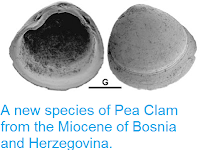Many Bivalves and other Animals living around deep-sea hydrothermal vents are host to communities of chemotrophic Bacteria, which produce bio-available carbon by the reaction of bicarbonate (dissolved carbon dioxide) with hydrogen sulphide compounds. These Animals are not unique and exotic creatures that have evolved separately from the fauna of the rest of the oceans, but rather members of common and widespread groups, suggesting the presence of a mechanism by which members of different groups can rapidly (in evolutionary terms) acquire the ability to host such endosymbiotic Bacteria.
One possibility that has been suggested is that symbiotic species found around hydrothermal vents have repeatedly evolved from wood-consuming species. Very few animals are able to directly consume wood, though a wide variety of species have adapted to a wood-based diet, relying on symbiotic Bacteria to break down the tough cellulose of which wood is composed. This not only leads to animals already adapted to hosting symbiotic Bacteria, but presents an opportunity for a switch to hydrogen sulphide consuming Bacteria, as rotting wood is a good source of such compounds. This could potentially also help to explain the distribution of hydrothermal vent communities (which are often very widely separated), as wood often drifts for very long distances between entering the sea and finally sinking to the ocean floor, so that wood-falls are very widely distributed in the oceans, and hydrogen sulphide producing rotting wood patches could provide stepping stones between distant hydrothermal vents. However, in the absence of any intermediate forms (i.e. animals which appear to be in the process of evolving from a wood-consuming lifestyle to a hydrogen sulphide absorbing one), this remains only an interesting hypothesis.
In a paper published in the Proceedings of the National Academy of Sciences of the United States of America on 17 April 2017, a team of scientists led by Daniel Distel of the Ocean Genome Legacy Center at Northeastern University, describe the lifestyle and endosymbiotic community of the Giant Shipworm, Kuphus polythalamia, and discuss whether it might represent an intermediate state between wood-consuming and hydrogen sulphide absorbing forms.
Shipworms, Teredinidae, are highly-modified, Worm-like Bivalve Molluscs which dwell inside wood that has fallen into the ocean (or, since Humans began to travel the seas, been used to construct vessels). The shells of these Molluscs are much reduced, forming a pair of opposable rasping ‘jaws’ at the mouth end of the animal, and a long, vermiform (Worm-shaped) body, which enables an elongate gut where wood is digested, using enzymes produced by Bacteria which live in specialized cells in the Mollusc’s gills.
The Giant Shipworm, Kuphus polythalamia, differs from other members of the group in two notable and obvious ways, it is much larger, reaching tens of centimetres in length, and it is not a wood-borer, being found either in rotten wood or organic rich muddy sediments. Closer examination of the Shipworms shows that the shell has become modified to form a calcareous cap, which completely covers the mouthparts, preventing feeding by ingesting food.
Comparative anatomy and life position of Kuphus polythalamia and Lyrodus pedicellatus. (A) Fresh specimen of Kuphus polythalamia removed from its calcareous tube, (B) calcareous tube of Kuphus polythalamia removed from sediment, (C) diagram depicting the anatomy and life position of Kuphus polythalamia in sediment, and (D) Inset from box in (C) depicting the anatomy and life position of the woodfeeding Shipworm Lyrodus pedicellatus in wood. Scale bars: (A)–(C), 5.0 cm; (D), 0.5 cm.) b, bacteria; c, cecum; g, gill; HS−, hydrogen sulfide; m, mouth; p, pallet; s, siphon; t, calcareous tube; v, valve (shell); vm, visceral mass. Distel et al. (2017).
Distel et al. extracted Bacteria from the gills of Kuphus polythalamia in order to sequence their genomes and determine their relationships to other endosymbionts in Shipworms and other organisms. While some of these Bacteria proved to be very closely related to Bacteria found in other Shipworms, there were also species found that were closely related to Bacteria found in the hydrothermal vent Gastropods Crysomallon squamiferum and Alvinoconcha hessleri, as well as the marine Ciliate Protozoan Zoothamnium niveum.
Kuphus polythalamia is clearly unable to ingest and digest wood, and lives either on rotten wood or organic rich much, rich in hydrogen sulphide compounds. It appears to ‘feed’ (gain organic carbon) by the action of hydrogen sulphide processing Bacteria, housed in structures present in other members of the group, and used to house wood-digesting endosymbionts in those species. This shows a clear shift from a wood-consuming to a hydrogen sulphide processing ecology, using existing structures for housing endosymbiotic Bacteria, in this species. This lends weight to the theory that this is a more widely followed path, that has enabled a variety of different species from widely separate groups to adopt to a hydrogen sulphide processing lifestyle in this way.
See also...
See also...
Follow Sciency Thoughts on Facebook.







